ThisiscontentfromElsevier'sDrugInformation
Buspirone
Learn more about Elsevier's Drug Information today! Get the drug data and decision support you need, including TRUE Daily Updates™ including every day including weekends and holidays.
7.5 mg PO twice daily, initially. May increase the dose by 5 mg/day every 2 to 3 days as needed. Usual dosage: 20 to 30 mg/day, in divided doses. Max: 60 mg/day. Coadministration of certain drugs may need to be avoided or dosage adjustments may be necessary; review drug interactions.[28501] [72235]
2.5 to 5 mg PO twice daily, initially. May increase by 5 mg/day every 3 to 7 days as needed. Usual dosage: 10 to 30 mg/day, in divided doses. Max: 60 mg/day. Guidelines do not consider buspirone a first-line option for the treatment of anxiety in adolescents due to inconsistent clinical trial results. In a small study of pediatric patients with anxiety disorder, doses of 5 to 30 mg PO twice daily were well-tolerated in adolescents and improved symptoms over 4 to 6 weeks of treatment.[62490] [67322] [70655] Coadministration of certain drugs may need to be avoided or dosage adjustments may be necessary; review drug interactions.[28501] [72235]
2.5 to 5 mg PO twice daily, initially. May increase by 5 mg/day every 3 to 7 days as needed. Usual dosage: 10 to 15 mg/day, in divided doses. Max: 60 mg/day. Guidelines do not consider buspirone a first-line option for the treatment of anxiety in children. Dosages exceeding 7.5 mg PO twice daily may be poorly tolerated.[62490] [67322] [70655] Coadministration of certain drugs may need to be avoided or dosage adjustments may be necessary; review drug interactions.[28501] [72235]
60 mg/day PO.
60 mg/day PO.
Safety and efficacy have not been established; dosages up to 60 mg/day PO have been used off-label.
6 to 12 years: Safety and efficacy have not been established. Up to 60 mg/day PO has been used off label, but dosages above 15 mg/day PO may be poorly tolerated.
1 to 5 years: Safety and efficacy have not been established.
Safety and efficacy have not been established.
Safety and efficacy have not been established.
Buspirone is not recommended for use in individuals with severe hepatic impairment.[28501][72235]
CrCl less than 30 mL/minute: Buspirone is not recommended for use in individuals with severe renal impairment or renal failure.[28501][72235]
Intermittent hemodialysis
Buspirone is not recommended in individuals with renal failure.[28501][72235]
† Off-label indication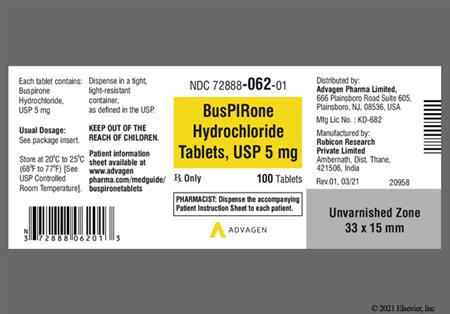
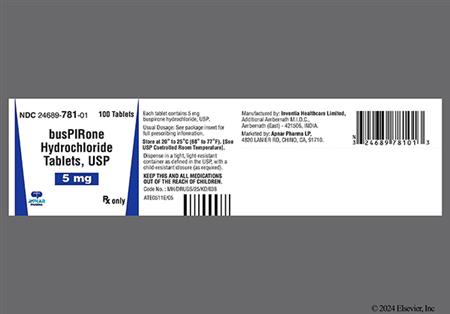
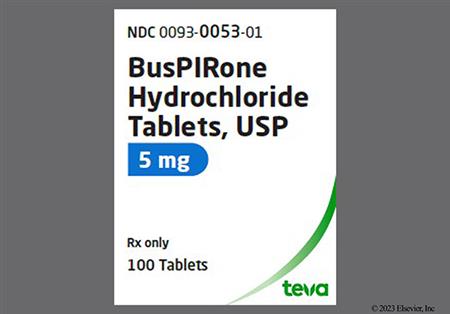
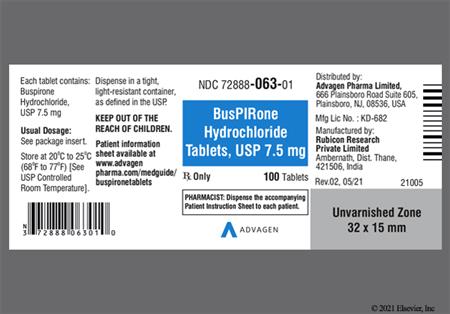
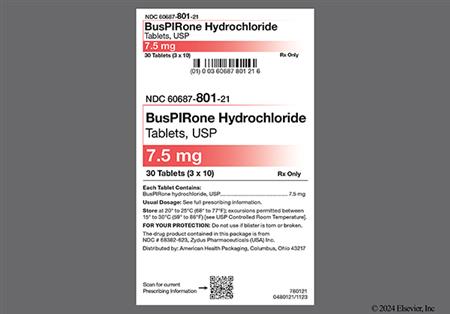
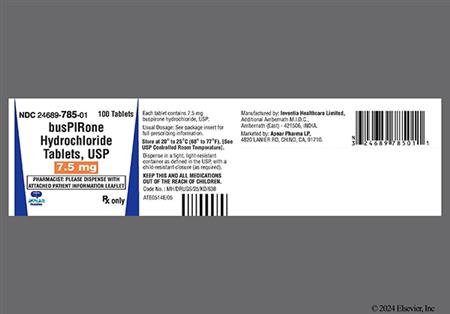
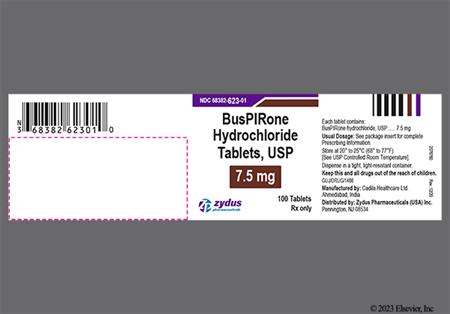
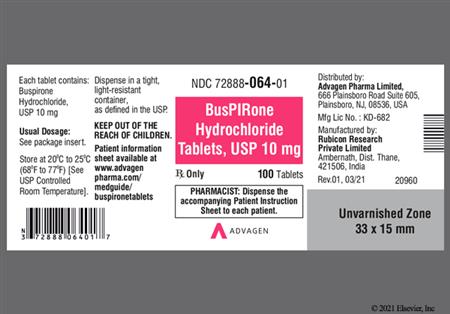
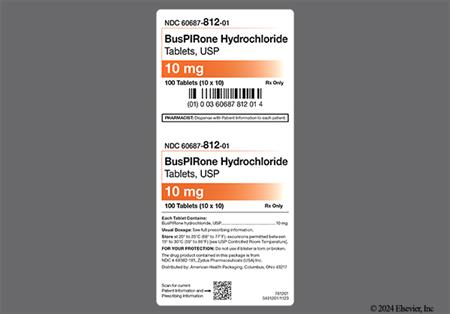
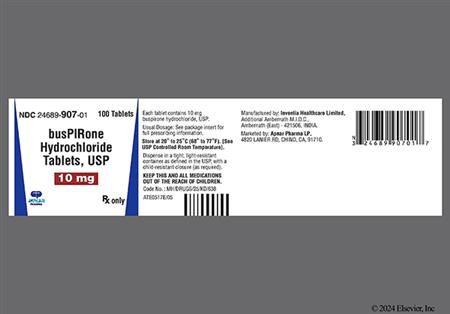
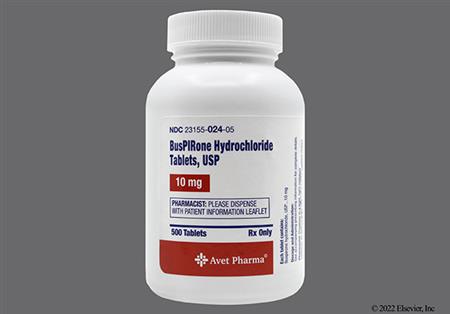
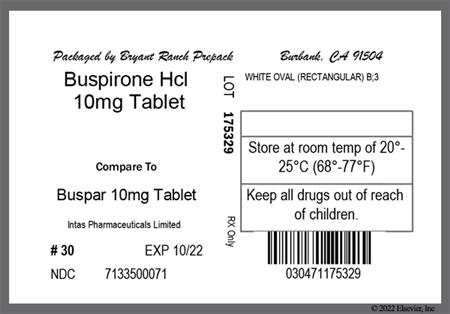
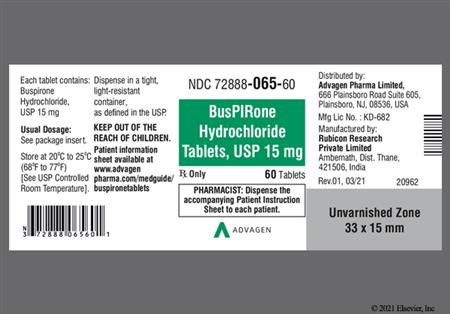
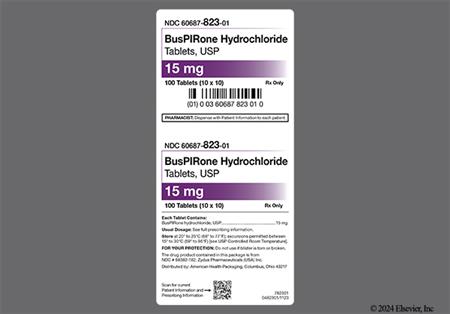
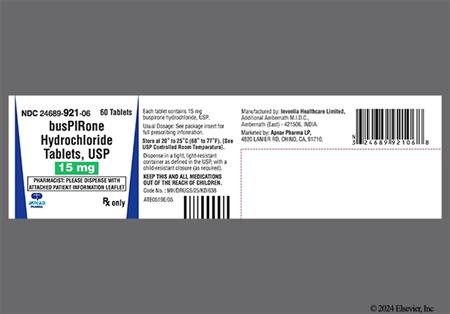
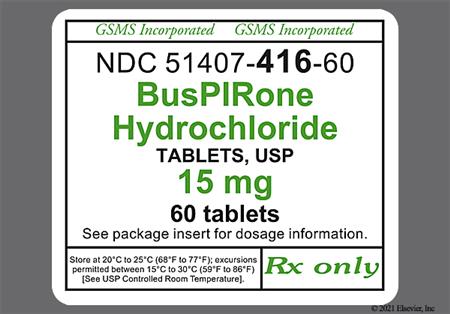
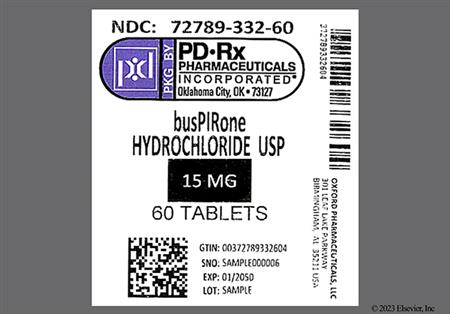
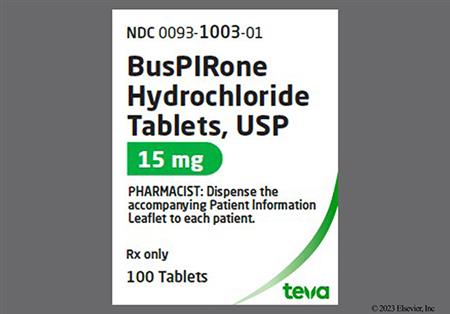
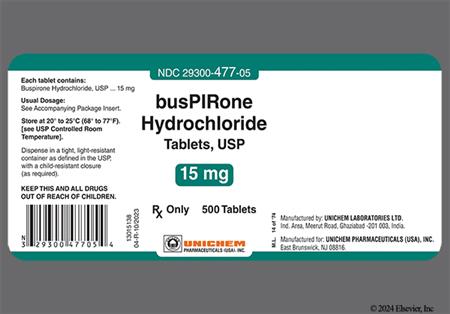
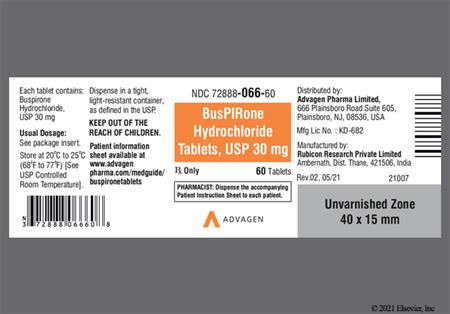
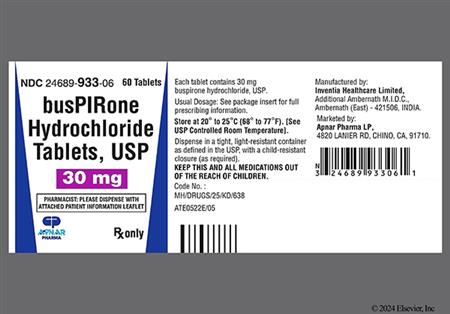
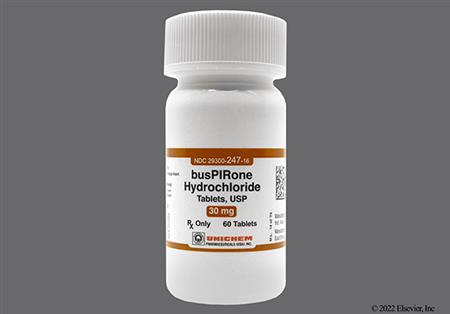
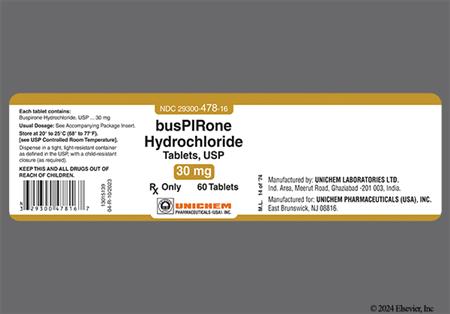
Buspirone is an oral anxiolytic that is structurally and pharmacologically distinct from all other anxiolytics. The clinical use of buspirone is limited to the treatment of generalized anxiety disorder (GAD) in adults.[28501] While used clinically off-label in pediatrics 6 years of age and older with anxiety, the efficacy of buspirone in pediatric patients with GAD has not been formally established, and guidelines do not recommend it as a first-line treatment in this population due to inconsistent study data.[62490][67322][70655] Results from clinical trials of buspirone for panic disorder in adults are generally unfavorable, and data on its use in social anxiety disorder and obsessive-compulsive disorder have produced mixed results. Evidence on the use of buspirone for post-traumatic stress disorder is too limited to be informative. Buspirone differs from other anxiolytics in that it does not possess anticonvulsant or muscle-relaxant properties, does not impair psychomotor function, and does not cause physical or psychological dependence. Unlike benzodiazepine anxiolytics, buspirone should not be used for the acute relief of anxiety because its onset of effect is delayed by 2 weeks or more. Buspirone was initially FDA-approved in 1986.[24025][28501][50829]
For storage information, see the specific product information within the How Supplied section.
Tablets
Capsules (e.g., Bucapsol)
Centrally-mediated (CNS) adverse effects were the most frequently occurring reactions during buspirone clinical trials and were among the most common events resulting in discontinuation of therapy (3.4%). Common causes of treatment discontinuation included dizziness, insomnia, nervousness, drowsiness, and lightheadedness. During clinical trials of buspirone in the treatment of anxiety, the following CNS effects occurred in at least 1% of subjects receiving buspirone and with a frequency greater than in placebo subjects: dizziness (12%), drowsiness (10%), nervousness (5%), lightheadedness (3%), excitability (2%), anger/hostility (2%), confusion (2%), numbness (2%), paresthesias (1%), incoordination (1%), tremor (1%), and headache (6%). During other premarketing evaluations, dream disturbances (abnormal dreams) were reported in at least 1% of subjects. CNS effects reported in 0.1% to 1% of subjects included depersonalization, dysphoria, noise intolerance, euphoria, akathisia, fearfulness, loss of interest, dissociative reaction, hallucinations, involuntary movements, slowed reaction time, suicidal ideation, and seizures. Rarely reported effects (less than 0.1%) included claustrophobia, cold intolerance, stupor, dysarthria, psychosis, and roaring sensation in the head. During postmarketing use, extrapyramidal symptoms (EPS) including pseudoparkinsonism (i.e., cogwheel rigidity, dyskinesia), dystonic reaction, akathisia, and tardive dyskinesia have been reported. Although causality has not been established, buspirone affects central dopamine receptors which may be a contributing factor in the development of extrapyramidal reactions. Other postmarketing events include dizziness/vertigo, ataxia, emotional lability, serotonin syndrome, transient difficulty with recall, restless legs syndrome (RLS), and restlessness. Unlike many other anxiolytics, buspirone does not appear to cause physical or psychological dependence.[28501] [72235]
During clinical trials of buspirone in the treatment of anxiety, musculoskeletal pain or aches (myalgia) occurred in 1% of subjects receiving buspirone and more frequently than in subjects receiving placebo. During other premarketing evaluations, musculoskeletal effects reported in 0.1% to 1% of subjects included muscle cramps, muscle spasms, rigid/stiff muscles, and arthralgia. Myasthenia was reported rarely (less than 0.1%).[28501] [72235]
During clinical trials of buspirone in the treatment of anxiety, the following dermatologic effects occurred in at least 1% of subjects receiving buspirone and more frequently than in subjects receiving placebo: skin rash (1%) and hyperhidrosis or clamminess (1%). During other premarketing evaluations, adverse dermatologic effects reported in 0.1% to 1% of subjects included edema, pruritus, flushing, easy bruising (hematoma), hair loss (alopecia), xerosis, facial edema, and blisters. Acne vulgaris and thinning of nails were reported rarely (less than 0.1%). During postmarketing use, allergic reactions (e.g., urticaria, angioedema) and ecchymosis have been reported. Because of the uncontrolled nature of these spontaneous postmarketing reports, a causal relationship to buspirone has not been determined.[28501] [72235]
During premarketing evaluation of buspirone, adverse hematologic effects including eosinophilia, leukopenia, bleeding disturbance (unspecified), and thrombocytopenia were reported in less than 0.1% of buspirone-treated subjects.[28501] [72235]
During clinical trials of buspirone in the treatment of anxiety, gastrointestinal (GI) disturbances, primarily nausea, were one of the most common adverse events causing discontinuation of treatment. In these clinical trials, the following adverse GI effects occurred in at least 1% of subjects receiving buspirone and more frequently than with placebo: nausea (8%) and diarrhea (2%). During other premarketing evaluations, adverse GI effects reported in 0.1% to 1% of buspirone recipients included elevated hepatic enzymes, flatulence, anorexia, appetite stimulation, hypersalivation, irritable colon, weight gain, weight loss, and rectal GI bleeding. Burning of the tongue was reported rarely (less than 0.1%).[28501] [72235]
During premarketing evaluation of buspirone, the following adverse respiratory effects or infections were reported in at least 1% of treated subjects: sore throat (pharyngitis) and nasal congestion. Adverse effects reported in 0.1% to 1% of buspirone recipients included hyperventilation, dyspnea, chest congestion, and fever. Epistaxis and hiccups were reported rarely (less than 0.1%).[28501] [72235]
During premarketing evaluation of buspirone, chest pain (unspecified) was reported in at least 1% of drug recipients. Adverse cardiovascular effects reported in 0.1% to 1% of treated subjects included syncope, hypotension, and hypertension. Rarely reported cardiovascular or cerebrovascular effects (less than 0.1%) included stroke, congestive heart failure, myocardial infarction, cardiomyopathy, and bradycardia.[28501] [72235]
During clinical trials of buspirone in the treatment of anxiety, blurred vision occurred in 2% of buspirone-treated subjects and more frequently than with placebo. During other premarketing evaluations, adverse effects related to the special senses reported in 0.1% to 1% of buspirone-treated subjects included tinnitus, redness of the eyes, ocular pruritus, dysgeusia, parosmia, and conjunctivitis. Inner ear abnormality, ocular pain, photophobia, pressure on the eyes, and loss of voice were reported rarely (less than 0.1%). Visual impairment (including tunnel vision) has been reported during postmarketing use. Because of the uncontrolled nature of spontaneous postmarketing reports, a causal relationship to buspirone treatment has not been determined.[28501] [72235]
During premarketing evaluation of buspirone, adverse endocrine effects including galactorrhea and thyroid abnormality (unspecified) were reported in less than 0.1% of subjects.[28501] [72235]
During premarketing evaluation of buspirone, the following adverse genitourinary effects or changes in sexual functioning were reported in 0.1% to 1% of buspirone recipients: increased urinary frequency, urinary hesitancy, menstrual irregularity and spotting, dysuria, libido decrease, and libido increase. Rarely reported effects (less than 0.1%) included amenorrhea, pelvic inflammatory disease, enuresis, nocturia, ejaculation dysfunction (delayed ejaculation), and impotence (erectile dysfunction). Urinary retention has been reported during postmarketing use.[28501] [72235]
During clinical trials of buspirone in the treatment of anxiety, weakness occurred in 2% of subjects receiving buspirone and more frequently than with placebo. During other premarketing evaluations, malaise was reported in 0.1% to 1% of subjects. Alcohol abuse was reported rarely (less than 0.1%).[28501] [72235]
The coadministration of certain medications may lead to harm and require avoidance or therapy modification; review all drug interactions prior to concomitant use of other medications.
This medication is contraindicated in patients with a history of hypersensitivity to it or any of its components.
Buspirone has a slow onset of action and does not exhibit cross-tolerance with benzodiazepines or other common sedative/hypnotic drugs. Buspirone will not block the withdrawal syndrome often seen with cessation of therapy in those with benzodiazepine dependence and should be used cautiously in people that are at increased risk for benzodiazepine withdrawal. People who are being converted from a benzodiazepine to buspirone therapy may need to overlap buspirone initiation with the gradual downward titration of the benzodiazepine to reduce the risk of withdrawal. Rebound or withdrawal symptoms may occur over varying time periods, depending on the type of medication used, the duration of use, and its effective half-life of elimination.[28501] [72235]
The use of buspirone in people with severe renal impairment or renal failure is not recommended. Buspirone is predominantly excreted by the kidneys, and people with impaired renal function demonstrated increased plasma levels and a prolonged half-life of buspirone compared to healthy individuals.[28501] [72235]
The use of buspirone in people with severe hepatic impairment (Child-Pugh class C) or hepatic failure is not recommended. A pharmacokinetic study in people with impaired hepatic function demonstrated increased plasma levels and a prolonged half-life of buspirone compared to healthy subjects.[28501] [72235]
Buspirone has the potential to impair judgment, thinking, or motor skills. Patients should use caution when driving or operating machinery or participating in other activities requiring coordination and concentration until they are reasonably certain that buspirone does not affect them adversely. While formal interaction studies of buspirone with alcohol indicate that buspirone does not increase alcohol-induced impairment in motor and mental performance, it is prudent to avoid concomitant use of alcohol and buspirone.[28501] [72235]
The safety and efficacy profiles of buspirone in geriatric adults are similar to those in younger adults; however, a lower initial dosage is recommended in geriatric adults.[28501] [72235] The U.S. Omnibus Budget Reconciliation Act (OBRA) regulates medication use in long-term care facilities. When buspirone is used to manage behavior, stabilize mood, or treat a psychiatric disorder, tapering as outlined in the OBRA guidelines should be attempted unless clinically contraindicated. Dosages and durations of treatment used should align with prescribing labels, published literature recommendations, and expert guidelines.[60742]
Clinical studies related to the use of buspirone in pregnancy and subsequent outcomes are limited. In a prospective analysis of data from the Massachusetts General Hospital National Pregnancy Registry for Psychiatric Medications, 68 pregnant people who gave birth to 72 infants reported use of buspirone during the first trimester of pregnancy. No major malformations were reported in any infants who were exposed to buspirone during the first trimester. Additional well-controlled studies with larger populations of pregnant patients are needed to further assess for potential risks related to buspirone exposure in pregnancy. No teratogenic effects have been observed in animal studies when using approximately 30 times the maximum recommended human dose (MRHD); however, animal reproduction studies are not always predictive of human response. The effects of buspirone during labor and delivery are unknown.[28501] [62732] [69030] [72235]
Use buspirone with caution during breast-feeding. Buspirone and its metabolites are excreted in the milk of lactating rats. Limited information indicates that doses of buspirone up to 45 mg/day produce low levels in human milk; however, there are no data on the long-term use of buspirone during lactation and the FDA-approved label recommends avoidance if clinically possible.[28501] [70364] [72235] Consider if an alternative would be appropriate. A pooled analysis found that maternal use of paroxetine usually produced undetectable or low drug concentrations in infant serum; this agent may be an option when initiating chronic therapy for generalized anxiety disorder (GAD) in a breast-feeding individual.[45642] For acute anxiety requiring a benzodiazepine, short-acting agents such as oxazepam or lorazepam may be considered; however, the breastfed child should be monitored for sedation, feeding difficulties, or other signs of toxicity which would indicate the need to discontinue the benzodiazepine.[46229] [61269] [62732] [70364]
The mechanism of action of buspirone is not clearly understood since anxiety may be mediated by more than one neuropathway. Buspirone is distinct from typical benzodiazepine anxiolytics in that it does not exert anticonvulsive or muscle relaxant effects. It also lacks a prominent sedative effect that is associated with more traditional anxiolytics. It has no affinity for benzodiazepine receptors and does not affect GABA binding in vitro or in vivo. Buspirone has a high affinity for serotonin 5-HT1A receptors which are found in high quantities in the dorsal raphe and the hippocampus. Buspirone binding to type 1A serotonin receptors occurs on presynaptic neurons in the dorsal raphe and on postsynaptic neurons in the hippocampus. Animal studies reveal that buspirone inhibits the firing rate of 5-HT-containing neurons in the dorsal raphe. The dominant action of buspirone is partial agonism or mixed agonism/antagonism at 5-HT type 1A receptors. Buspirone also has moderate affinity for brain dopamine D2 receptors and is believed to enhance noradrenergic and dopaminergic neuronal activity. The combination of these effects leads to relief of anxiety symptoms without significant sedation or psychomotor impairment.[24025][28501]
Revision Date: 10/15/2025, 01:33:00 AMBuspirone is administered orally. Buspirone undergoes extensive first-pass metabolism, leaving only 1% of unchanged drug in plasma. Approximately 86% of buspirone is bound to plasma proteins. Buspirone is oxidized in the liver primarily by CYP3A4. Animal models indicate that the major active metabolite, 1-pyrimidinylpiperazine (1-PP), has one-fourth of the activity of buspirone. In addition, blood samples from humans chronically exposed to buspirone hydrochloride do not exhibit high levels of 1-PP. Other hydroxylated metabolites are inactive. The average elimination half-life of buspirone is about 2 to 3 hours in healthy adults. In a single-dose study, 29% to 63% of a buspirone dose was excreted in the urine within 24 hours, primarily as metabolites. Fecal excretion accounted for 18% to 38% of the dose.[28501][72235]
Affected cytochrome P450 (CYP450) isoenzymes and drug transporters: CYP3A4
Buspirone is metabolized primarily by CYP3A4. When administered with a potent inhibitor of CYP3A4, a low dose of buspirone and caution are recommended. Low doses of buspirone, as well as subsequent dose adjustments, may be required during coadministration of moderate CYP3A4 inhibitors. When used in combination with a potent inducer of CYP3A4, an increased dose of buspirone may be needed to maintain the anxiolytic effect.[28501][72235]
Buspirone capsule and tablet formulations are bioequivalent.[72235] After oral administration, buspirone is rapidly absorbed. Extensive first-pass metabolism results in plasma concentrations of buspirone that are low and variable between individuals. Because buspirone exhibits non-linear pharmacokinetics, dose increases and repeated dosing may lead to somewhat higher blood levels of unchanged buspirone than would be predicted from results of single-dose studies. When given with food, the AUC and Cmax of buspirone increase by roughly 84% and 116%, respectively; however, the total amount of buspirone does not change. Therefore, food may decrease the pre-systemic clearance of buspirone.[28501] For this reason, buspirone should be taken in a consistent manner with regard to the timing of dosing; either always with or always without food.[28501][72235]When given with food, the AUC and Cmax of buspirone capsules increased by 84% and 17%, respectively. The Cmax of 1-PP decreased 33% while the AUC did not differ significantly. When the capsule was opened and its contents administered in 1 ounce (30 mL) of applesauce following a meal, the AUC and Cmax of buspirone increased by 100% and 40%, respectively, compared to the intact capsule in the fasted state. The Cmax of 1-PP decreased 34% while AUC was unaffected.[72235]
A pharmacokinetic study in individuals with impaired hepatic function demonstrated increased plasma levels and a prolonged half-life of buspirone. After multiple-dose administration to individuals with hepatic impairment, steady-state AUC of buspirone increased 13-fold, compared with healthy adults. Therefore, the administration of buspirone to individuals with severe hepatic impairment is not recommended.[28501][72235]
A pharmacokinetic study in individuals with impaired renal function demonstrated increased plasma levels and a prolonged half-life of buspirone. After multiple-dose administration to individuals with renal impairment (i.e., CrCl 10 to 70 mL/minute), the steady-state AUC of buspirone increased 4-fold compared with healthy adults. Therefore, the administration of buspirone to individuals with severe renal impairment is not recommended.[28501][72235]
Pharmacokinetic studies have shown that, for identical doses (i.e., 7.5 to 30 mg twice daily), plasma exposure to buspirone and its active metabolite, 1-PP, are equal to or higher in pediatric patients (age 6 to 17 years) than adults. No unexpected safety findings were associated with buspirone in these trials.[28501]
After single or multiple doses in adults, no significant differences in buspirone pharmacokinetics (AUC and Cmax) were observed between elderly and younger adult subjects.[28501]
After single or multiple doses in adults, no significant differences in buspirone pharmacokinetics (AUC and Cmax) were observed between men and women.[28501]
The effects of race or ethnicity on the pharmacokinetics of buspirone have not been studied.[28501]
Clinical studies related to the use of buspirone in pregnancy and subsequent outcomes are limited. In a prospective analysis of data from the Massachusetts General Hospital National Pregnancy Registry for Psychiatric Medications, 68 pregnant people who gave birth to 72 infants reported use of buspirone during the first trimester of pregnancy. No major malformations were reported in any infants who were exposed to buspirone during the first trimester. Additional well-controlled studies with larger populations of pregnant patients are needed to further assess for potential risks related to buspirone exposure in pregnancy. No teratogenic effects have been observed in animal studies when using approximately 30 times the maximum recommended human dose (MRHD); however, animal reproduction studies are not always predictive of human response. The effects of buspirone during labor and delivery are unknown.[28501] [62732] [69030] [72235]
Use buspirone with caution during breast-feeding. Buspirone and its metabolites are excreted in the milk of lactating rats. Limited information indicates that doses of buspirone up to 45 mg/day produce low levels in human milk; however, there are no data on the long-term use of buspirone during lactation and the FDA-approved label recommends avoidance if clinically possible.[28501] [70364] [72235] Consider if an alternative would be appropriate. A pooled analysis found that maternal use of paroxetine usually produced undetectable or low drug concentrations in infant serum; this agent may be an option when initiating chronic therapy for generalized anxiety disorder (GAD) in a breast-feeding individual.[45642] For acute anxiety requiring a benzodiazepine, short-acting agents such as oxazepam or lorazepam may be considered; however, the breastfed child should be monitored for sedation, feeding difficulties, or other signs of toxicity which would indicate the need to discontinue the benzodiazepine.[46229] [61269] [62732] [70364]
Cookies are used by this site. To decline or learn more, visit our cookie notice.
Copyright © 2025 Elsevier, its licensors, and contributors. All rights are reserved, including those for text and data mining, AI training, and similar technologies.